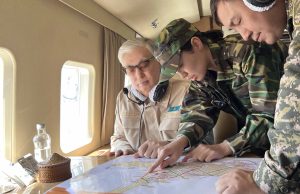On June 15, Kazakhstan’s Ministry of Emergency Situations announced that the massive forest fires in the eastern Abay region were under control. A week later, the fires and Kazakhstanis’ frustration with how the government handled the emergency continue to smolder.
The question of who should shoulder responsibility – and with what consequences – is at the center of public discussion in Kazakhstan right now. The general prosecutor announced it would conduct a criminal investigation regarding the fire’s causes, and Tokayev reprimanded several government officials. Patterns in who was punished and to what extent offer some insight on how Tokayev views the chain of responsibility, though this does not necessarily map onto broader public opinion.
For example, Abay region’s governor Nurlan Urankhaev was let off with a stern scolding from the president. “I understand that the region is new, you are the new governor,” Tokayev said. “For these reasons, I am reprimanding you. In principle, you could be fired for this immediately.” Indeed, Abay oblast was only fully reinstated in June 2022 after being merged into East Kazakhstan oblast in 1997.
Kazakh political bloggers and social media users are calling for consequences for East Kazakhstan oblast’s governor, Danial Akhmetov. Akhmetov, a political veteran who previously served as prime minister and was the country’s longest serving governor, was relieved of his post on June 16.
It’s not clear that Akhmetov’s departure from the governorship is related to the fires, though. Akhmetov’s term had been extended several times since he became governor in 2014, and the last one-year extension was offered in June 2022. There is further evidence that Akhmetov is not being directly targeted insofar as the general prosecutor did not indicate that Akhmetov would be interrogated as part of their investigation.
The regional governors are responsible to the extent that the fires happened within their jurisdictions, but oversight of forestry and emergency response is officially controlled at the national level. Tokayev criticized cabinet-level officials in very different registers.
On June 10, he promptly fired the Minister of Emergency Situations Yuri Ilyin, who had held the post since 2020. But Zulfiya Suleimenova, who heads the Ministry of Ecology, which oversees forestry, has kept her job. Suleimenova, who at 33 is the country’s youngest-ever minister, has only held the position since January 2023. She accepted responsibility for her role in the fires on June 19, but Tokayev has not publicly criticized her.
Public opinion on Suleimenova appears to be mixed. A video of Suleimenova tearing up while meeting with families of forestry workers who died fighting the fires made headlines, and local media do not appear to be excessively critical of the minister. On June 10, Suleimenova posted her condolences on social media, sparking more than 650 comments on Instagram. Many of the comments are critical, questioning how a “girl” could become minister in the first place and calling for her resignation. But other users defended Suleimenova, arguing that her six-month tenure could not be long enough to reform a deeply corrupt government body.
Discussions of corruption and the Abai forest fires have largely focused on regional leaders and mid-level bureaucrats. But some of the voices of Kazakhstan’s opposition are trying to keep the focus of criticism on the structure of Kazakhstan’s government and the consequences of concentrating power in the presidency.
Qazaq Koktemi – an artist collective whose name means “Kazakh spring,” which has been active since the spring of 2019 – installed a large wooden cube in central Almaty on June 19. Azattyq reported that authorities removed the piece, called “Truth,” within just a few hours. But photographs of the piece remain, allowing the art’s message to travel further.
One side of the cube reads, “Bullets fired at the people / The rotten authorities are full / Future generations are left with coal.” The phrase, which rhymes in Kazakh, ends with a play on words; the word for coal can also signify discord, suggesting that as officials benefit from corruption, average people are stuck fighting over scraps.
Portraits of Nazarbayev and Tokayev flank another face of the cube. Between them is a word cloud of various tragedies and violence that Kazakhstanis have suffered at the hands of the state, both structural, like oligarchy and bribery, and individual, as with the deaths of rights defenders and opposition figures. Zhanaozen 2011, Qandy Qantar (“Bloody January,” a reference to the violence of January 2022), and Abay 2023 are bolded in the largest font, signifying that Qazaq Koktemi is drawing a clear line between these tragedies.
However, it does not seem that this episode is bubbling over into sustained, organized demand for reform, as happened with the July 2018 murder of Denis Ten or the 2019 Astana house fire that killed five children. Unfortunately, given that climate change threatens to exacerbate the impacts of natural disasters, it is only a matter of time until fire, drought, floods, or smog facilitate political mobilization.































